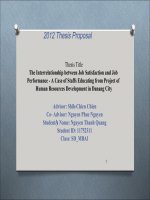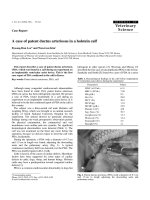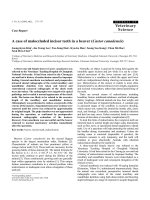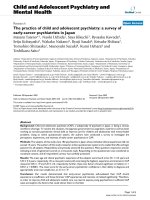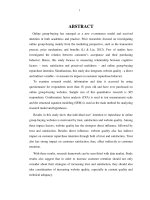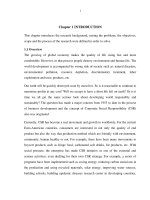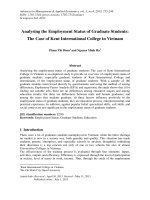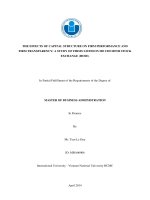Export performance and stock return: a case of fisheries firms listing in Vietnam stock markets
Bạn đang xem bản rút gọn của tài liệu. Xem và tải ngay bản đầy đủ của tài liệu tại đây (215.92 KB, 16 trang )
Vo Thi Quy | 605
Export performance and stock return:
A case of fisheries firms listing
in Vietnam stock markets
VO THI QUY
International University, Vietnam National University HCMC –
Abstract
This research aims to study the relationship between export performance and stock return of
Vietnamese fishery companies. To conduct this study, quarterly data was collected for period from
2010-2015 of 13 fishery companies listing in Ho Chi Minh Stock Exchange (HOSE) and Ha Noi
Stock Exchange (HNX). The export performance was measured by export intensity, export
growth and export market coverage. In addition, interest rate, exchange rate, GDP, firm size,
profitability and financial leverage were considered as the control variables in the research model.
Panel data analysis with Pooled OLS model was employed to estimate the predictive regression.
The findings indicated that export intensity has a significant and positive relationship with stock
returns. However, export growth and export market coverage have no a significant relationship
with stock return at the 0.05 level. The findings also showed the profitability and exchange rate
has a positive relationship, while interest rate and financial leverage has a negative relationship
with stock return. GDP has no relation to stock return at the 0.05 significance level.
Keywords: export performance; stock returns; fishery industry; HOSE and HNX.
1. Introduction
Many studies have been conducted on the determinants of stock return. Researchers
have found that economic factors (e.g., GDP, interest rate, and inflation rate) and
company factors (e.g., profitability, financial leverage, and dividend policy) have a
significant impact on stock returns. However, a few studies on the influence of export
performance of exporters on their stock return. VN-index increased sharply and reached
1170 points as Vietnam became the member of WTO in 2007, and responded positively as
Vietnamese government signed the Trans-Pacific Partnership (TPP) Agreement on 5,
October 2015. In the week from 30 September 2015 to 5 October 2015, VN-Index rose 24.5
606 | ICJED2017
points; the average trading volume of the market reached 208 million shares per day, a
double increase of the average trading volume of previous weeks. Average trading value
also increased twice, reaching 3,700 billion VND per day. The price of exporters’ stocks
increased dramatically such as TCM increasing 12.68%, TNC increasing 17.15%, HCV
increasing 14.4%, etc. In general, Vietnamese stock markets seem to respond positively
as Vietnamese economy integrated with global economy. Therefore, this research
attempted to study the relationship between export performance and exporters’ stock
returns in Vietnamese stock markets from 2010 to 2015 with case of fishery industry.
2. Literature review
Export performance and stock return
Export oriented strategy also called “export led growth” was suggested by Ricardo and
Smith in the 19th century based on the theory of comparative advantage of country. The
theory supports the exchange of products/services between countries in international
trade. Exporters gain competitive advantages through economic of scale, according to
Giles and William (2000). Singapore, Hong Kong, Taiwan, and South Korea have achieved
the fast growth by applied successfully export oriented strategy, and become the Asian
Tigers (Todaro & Smith, 2006).Thefollowers are Malaysia, Thailand, Philippines, and
Indonesia. Vietnam, Cambodia, and Myanmar are also trying to repeat the success of East
and Southeast Asian countries.
Lal and Rajapatirana (1987) argued that exporting boosts company’s sales and expand
its markets to regional and worldwide beside the local markets leading to the
improvement of company’s performance. The reaching the economics of scale increases
the company’s profitability, in turns impacts positively on the company’s stock price.
Export performance is the outcome of a firm’s activities in export market (Zou et. al,
1998). It is categorized in two broad groups of measures: Financial/ economic and nonfinancial/non-economic measures presented in Table 1 below. Even though many
variables used as measures of export performance, some of them seem to be used
considerably more than others, this study used export intensity, export sales growth and
export market coverage to measure export performance.
Vo Thi Quy | 607
Table 1
Measurements of export performance
Category
Authors (year)
Measures
- Export profitability
Bilkey, W.J (1982)
- Export profitability growth
- Export profit margin
- Export profit ratio
- Export market share
Economic measures
- Sales- related indicators
- Profit-related indicators
- Market-share related
indicators
Archarungroj & Hoshino
(1998)
- Export market coverage
- Export market share growth
- Profitability rate of export
- Market share
Haghighi et. al., (2008)
- Sales volume
- Profitability
Hosseini &
Mirijahanmard (2011)
Sousa, Bradley (2004)
- Export sales growth
- Export profitability
- Export intensity
- Profitability of export
- Growth in export sales
- Perceived export success
Ibeh and Wheeler, 2005
Non-economic measures
- Achievement of export
objectives
- Satisfaction with export
performance
- Strategic export performance
- Meeting expectation
Sousa, Bradley (2004)
- How competitors rate firm’s
export performance
Source: Developed by author
Carde Maurel (2008) showed that companies with higher export performance have
higher profitability. Bernard and Jensen (1999) found that exporters have a better
financial wealth than non-exporters. However, the findings of studies on relationship
between export performances and stock return did not bring about the same results.
Bakhtiari (2001) did not find a significant relationship between export earnings and stock
price in food firms listed in Tehran Stock Exchange. However, Yodollah, et al. (2013)
608 | ICJED2017
indicated a significant relationship between export revenues and stock return on chemical
firms in the same stock market.
Vietnam fishery industry overview
With a coastline of 3.260 km and favorable natural condition for the development of
aquaculture and fishing industry, the fishery has been contributed an important part in
the development of Vietnamese economy. Vietnam has been the five largest seafood
exporters in the world together with Indonesia and Thailand, and the third in fishery
aquaculture and production, after India and China. The export turnover of Vietnamese
seafood products has increased steadily from 2000-2015. However, from 2012 to 2015,
the export value reduced significant because of the reducing demand of some major
markets such as Japan and EU.
The selected firms as the sample of this study includes 13 fishery firms listed in HOSE
and HNX before 2010. They are the leading exporters of Vietnam fishery industry. Their
products are exporting to the United States, European countries, Japan, and South Korea.
And now they have expanded their foreign markets to Middle East countries, African
countries. The overview of their export performance from 2010 to 2015 was summarized
in Table 2 below.
Table 2
Export performance of selected firms from 2010 to 2015
Year
Average Export
Intensity
Average Export
Growth
Average Export
Market Coverage
2010
0.756
0.21
18.15
2011
0.736
0.07
16.35
2012
0.738
0.06
16.58
2013
0.738
0.09
17.27
2014
0.756
0.14
19.10
2015
0.699
(0.07)
19.12
Source: Ministry of Industry and Trade (2016)
In order to test the relationship between export performance and stock return, the
conceptual framework below was proposed.
Vo Thi Quy | 609
Figure 1. Conceptual Framework
Variables and measurement
Dependent variable
In this study, stock return (St) is dependent variable and calculated quarterly by the
formula: St = (P1 – P0)/P0, where: P1: average adjusted closing stock price of quarter t;
and P0: average adjusted closing stock price of quarter t-1.
Independent and control variables:
•
Export intensity (Ei) = Total export revenue/ total sales
•
Export growth (Eg) = (Total export revenue quarter t – Total export revenue
quarter (t-1))/Total export revenue quarter (t-1).
610 | ICJED2017
•
Export market coverage (Em) is measured by the number of countries which
the firms is exporting their product to or export market coverage = total
number of company’s foreign markets.
•
Control variables:
•
Profitability (Pr) = Earnings after tax/ total asset
•
Firm size (Size) = Ln (Total asset)
•
Leverage (De) = Total debt/ Total asset.
•
Interest rate (Ir) was collected from the website of Vietnam Commercial Bank
(VCB).
•
Exchange rate (Ex) used is direct exchange rate (USD/VND), and collected
from the website of Vietnam Commercial Bank (VCB).
•
Gross domestic product (GDP) growth rate is nominal GDP collected from
Thomson Reuters page, GDP = Ln (GPD)
Model specification
St= β1 + β2Ei + β3Eg + β4Em+ β5Pr+ β6Size + β7De + β8GDP +β9Ex + β10Ir+ ɛ
Where:
•
St: Stock returns
•
Ei: Export intensity
•
Eg: Export growth
•
Em: Export market coverage
•
Pr: Profitability
•
Size: Firm size
•
De: Financial leverage
•
GDP: Ln (GDP)
•
Ex: Exchange rate
•
Ir: Interest rate
Vo Thi Quy | 611
Hypotheses in research
H1: Export intensity has a significant positive relationship with stock returns
H2: Export growth has a significant positive relationship with stock returns
H3: Export market coverage has a significant positive relationship with stock returns
H4: Profitability has a significant positive relationship with stock returns
H5: Firm size has a significant negative relationship with stock returns
H6: Financial leverage has a significant negative relationship with stock returns
H7: GDP has a significant positive relationship with stock returns
H8: Exchange rate has a significant positive relationship with stock returns
H9: Interest rate has a significant negative relationship with stock returns
3. Data collection
There are 13 fishery firms listed in HOSE or HNX from 2010. Financial data was
collected from these firms’ financial reports from 2010 to 2015 with total observation of
312 quarterly data points; GDP collected from Thomson Reuters; Interest rate and
exchange rate collected from Vietcombank website. Stock price was collected from
. Export revenue and export market of selected firms were
collected from the report of Ministry of Industry and Trade.
4. Statistical description and results
Descriptive statistics (Table 3) indicate that the average stock returns (St) of fishery
firms are in the range from -74.68% to 74.60% with standard deviation (Std.Dev) of
17.79%. The average export intensity (Ei) of selected fishery firms is 73.71% in the period
from 2010 to 2015. The highest export intensity is 99.03%, the lowest is 0% (Q4/2015,
ATA) and standard deviation is 20.43%. It showed that export revenues contributed the
large portion of the companies’ revenues. The average export growth (eg) is 8.35%, the
highest export growth rate is 474%, the lowest is -100%, and standard deviation is
47.60%. With market coverage (Em), the average number of foreign markets that
selected fishery firms exported to is 18, the highest number is 55, the lowest is zero due
to ATA had no export revenues in fourth quarter of 2015.
612 | ICJED2017
Table 3
Descriptive statistics, 312 observations
Variable
St
Ei
Eg
Em
Pr
De
Size
Ir
lnGDP
Ex
Mean
-0.0013
0.7371
0.0835
17.759
0.0122
0.4332
11.9208
0.0914
14.2134
20791.63
Median
-0.0203
0.8028
0.0351
17.000
0.0060
0.4473
11.8586
0.08
14.3396
20919.50
Std. Dev.
0.1779
0.2043
0.4760
11.0827
0.0164
0.2429
0.4732
0.0286
0.6822
853.98
Min
-0.7468
0
-1
0
-0.0405
0
10.8349
0.06
12.8018
18813.00
Max
0.7460
0.9903
4.7457
55
0.1199
2.6667
13.1974
0.14
15.2489
22371.00
Skewness
0.5256
-1.0678
0.9192
0.7645
1.8346
1.1004
0.2274
0.6075
-0.3971
-0.7771
Kurtosis
5.2812
3.4209
4.9204
3.3632
8.9567
4.0464
3.0150
1.9728
2.1862
3.4142
Unit root test results
In order to obtain the effective estimators for regression analysis with times series data
the test for stationarity should be conducted to avoid spurious regression problem. To
test the stationarity for panel data, we used Levin-Lin-Chu (LLC Test, 2002) and ImPesaran-Shin (IPS Test, 2003) techniques. Both techniques test the null hypotheses of a
unit root, and the results shown in Table 4 below.
Table 4
Unit root testing results
Variables
St
Ei
Eg
Em
Pr
De
Size
Ir
Ln(GDP)
Ex
LLC
Stat.
-4.7193
-3.9661
-10.8504
-2.4763
-6.1132
-34.4734
-1.6885
-6.9341
-9.0442
-2.1076
IPS
Prob.
0.0000
0.0000
0.0000
0.0066
0.0000
0.0000
0.0457
0.0000
0.0000
0.0175
Stat.
-7.5380
-7.0201
-10.6641
-4.0545
-6.4944
-3.9997
-1.9659
-7.1903
-8.6688
-5.8633
Prob.
0.0000
0.0000
0.0000
0.0000
0.0000
0.0000
0.0247
0. 0000
0.0000
0.0000
Vo Thi Quy | 613
Table 4 shows that there is no evidence of presence of a unit root for all of the variables;
therefore, all variables are stationary at a significance level of 5%.
Multicollinearity test
As two or more independent variables in multiple regression models are highly
correlated, it would cause multicollinearity problem that generates ineffective regressors.
The matrix of correlation analysis between individual variables is the easiest way to figure
out the multicollinearity problem.
The matrix of the correlation coefficient (Table 5) shows that the magnitude
correlation between these variables less than 0.7; therefore it is unlikely to occur
multicollinearity in the model. Conducted with VIF test also resulted in the same
conclusion (Table 6). The coefficient VIF of all variables are less than 10 and the average
of VIF is equal 1.53 or there is no multicollinearity phenomenon existing in regression
model.
Table 5
Correlation Matrix
St
Ei
Eg
Em
Pr
De
Size
Ir
Ln(GDP)
Ex
St
1
0.1451
0.0063
0.0466
0.0885
-0.0534
0.0447
-0.119
0.0341
0.1374
Ei
Eg
Em
1
0.1396
0.0378
0.2073
-0.157
-0.251
0.0285
-0.067
-0.08
1
-0.037
0.0051
0.0552
-0.034
0.0019
0.1474
-0.108
1
0.1077
-0.216
0.671
-0.086
0.0603
0.031
Pr
De
1
-0.091
1
-0.013 -0.046
0.2496 0.0289
-0.073 0.0541
-0.216 0.0996
Size
Ir
lngdp
Ex
1
-0.107
0.0916
0.1433
1
-0.313
-0.29
1
0.5186
1
Table 6
VIF Testing results
Variable
Size
Em
Er
Lngdp
Pr
VIF
2.23
2.12
1.71
1.54
1.35
1/VIF
0.447736
0.470963
0.586179
0.648167
0.73824
614 | ICJED2017
Variable
Ei
Ir
Eg
De
Mean VIF
VIF
1.34
1.3
1.12
1.1
1.53
1/VIF
0.745477
0.768769
0.891729
0.908015
Regression results
To test the research hypotheses we run regression with the three models, Pooled OLS,
FEM and REM. To test assumptions of Pooled OLS model, we performed
heteroskedasticity testing through White’s test and autocorrelation by Wooldridge test.
White’s test showed result that Prob > chi 2 = 0.1163 > 0.05, we accept H0 or there is no
the existence of the heteroskedasticity phenomenon in the model. The autocorrelation
testing resulted in Prob> F =0.3283 > 0.05, or H0 was accepted, i.e. there is no
autocorrelation problem in the model.
However, Pooled OLS method may be suspected because of not considering
unobserved heterogeneity or characteristics of each enterprise; therefore the FEM and
REM was used. Finally, choosing model was done through the Hausman and BreuschPagan tests, and the results showed in Table 7 and Table 8 below:
Table 7
Summary of regression models and testing results
Variables
Ei (Export intensity)
Eg (Export growth)
Em (Export market
coverage)
Pr (Profitability)
De (Financial
leverage)
Size (Firm size)
Pooled OLS
FEM
REM
0.13836**
(0.011)
0.00442
(0.839)
-0.00019
(0.880)
1.37951**
(0.034)
-0.05967**
(0.021)
0.02569
(0.403)
-0.80323**
0.12408
(0.113)
0.00139
(0.951)
0.00034
(0.890)
1.39432
(0.102)
0.04428
(0.518)
0.0731
(0.554)
-0.72497*
0.13836**
(0.01)
0.00442
(0.839)
-0.00019
(0.88)
1.37951**
(0.033)
-0.05967
(0.160)
0.02569
(0.403)
-0.80323**
Vo Thi Quy | 615
Ir (Interest rate)
(0.034)
-0.0223
(0.076)
-0.02243
(0.033)
-0.0223
(0.214)
(0.219)
(0.213)
LnGDP
0.0000350**
(0.016)
-0.78738*
(0.08)
Ex (Exchange rate)
_Cons
White’s test
Wooldridge test
Hausman test
Time fixed effects test
Breusch – Pagan test
0.0000319*
0.0000350**
(0.065)
(0.015)
-1.285
-0.78738*
(0.336)
(0.078)
Prob> chi2=0.1163
Prob> F = 0.3283
Prob> chi2 = 0.9956
Prob>F = 0.9842
Prob> chi2 = 1.00
Significant: * p<0.1, ** p<0.05, *** p<0.01
Table 8
Testing results for choosing the model
H0
Result
P-Value
Hausman
Time fixed effects
Breusch – Pagan
FEM and REM do not
All coefficient of
Pooled OLS
differ substantially or
REM is more efficient
model equal 0 or
Pooled OLS is more
regression model is
more appropriate than
than FEM
efficient than FEM
REM
Chi2 (8) = 1.3
Prob > Chi2 =0.9956
F (12,290) = 0.33
Prob > F = 0.9842
Chi2 (01) = 0.00
Prob > Chi2 =1.00
As a result, the most appropriate regression result is Pooled OLS model. Pooled OLS
was chosen to explain the relationship between export performance and stock returns as
the objective of this study. It was used as the final results for analysis.
The findings showed five variables being exports intensity, profitability, financial
leverage, interest rate and exchange rate have a significant impact on stock return at 0.05
levels. Especially, export intensity, profitability and exchange rate have a positive
relationship with stock returns; while the financial leverage and interest rate have a
negative relationship with stock returns. Four other variables being export growth, export
market coverage, GDP and firms size have a statistically insignificant relationship with
stock returns at the 5% level.
616 | ICJED2017
Table 9
Pooled OLS regression model
Variables
Pooled OLS
Ei
(Export intensity)
0.13836**
(0.011)
Eg
0.00442
(Export growth)
(0.839)
Em
-0.00019
(Export market coverage)
(0.880)
Pr
1.37951**
(Profitability)
(0.034)
De
-0.05967**
(Financial leverage)
(0.021)
Size
(Firm size)
0.02569
(0.403)
Ir
-0.80323**
(Interest rate)
(0.034)
LnGDP
-0.0223
(0.214)
Ex
0.0000350**
(Exchange rate)
(0.016)
_Cons
-0.78738
(0.08)
Significant: ** p<0.05, *** p<0.01
5. Conclusions and implications
The main purpose of this study is to investigate the effect of export performance with
measures namely, export intensity, export growth, export market coverage on stock
returns of fishery industry and to determine the predictors of stock return. The study
resulted in that export intensity has a significant relationship with stock return and
Vo Thi Quy | 617
showed positive effects. However, export growth and export market coverage have an
insignificant relationship with stock return. This showed that the export intensity can be
considered as an explanatory variable on stock return of fishery industry. Stock return
will increase with increasing fishery firms’ export intensity.
The findings may be helpful for investors, firm managers and policy makers for their
own purposes. Investors should consider the export intensity instead of export growth
and export market coverage as buying stock of fishery exports firms. Manager should
increase export intensity to attract more investors and increase their company’s stock
price. Besides that, policies makers should have suitable policies of interest rate and
exchange rate to encourage and create favorable conditions for export activities.
The study has some limitations. The study just conduct on an industry with small
sample is 13 companies in fishery industry in period from 2010-2015; therefore, the
generality of the study’s findings is limited. Further study should increase the sample size
by extending to other exporting industries.
References
Abugri, B. A. (2008), Empirical relationship between macroeconomic volatility and stock returns: Evidence
from Latin American markets, International Review of Financial Analysis, Vol.17, Issue 2, 396–410
Aggarwal, R (1981). Exchange rate and stock price: A study of the US capital markets under floating
exchange rates, Akron Business and Economic review, Vol.12, 7-12
Amir and Soleyman Haghiri ,2012. The Investigation of Effective Factors on Stock Return with Emphasis
on ROA and ROE Ratios in Tehran stock exchange (TSE), Journal of Basic and Applied Scientific
Research. 9100-9101
Archarungroj, P.&Y.Hoshino, 1998. The impact of Firm Size on Export performance and Attitudes: An
Empirical study on Thailand Exporter. Japanese journal of Administrative Science, 12, 79-88
Bernard, A.B and Jensen, J.B.1999. Exceptional exporter performance: cause, effect or both. Journal of
Finance, Vol.47, No.1, 1-25
Bhandari L C 1988. Debt/Equity Ratio and Expected Common Stock Returns: Empirical Evidence. Journal
of Finance, XLIII 507-528
Bilkey, W.J. (1982) Variables associated with export profitability. Journal of International Business
Studies.13 (2): 39-55
Carolo Maurel, 2008. Financial approach to export performance in French Wine SMEs. 4th International
conference of the Academy of wine business research, 17-19 July 2008, 13.
618 | ICJED2017
Dimitrov V and Jain P C 2005. The Value Relevance of Changes in Financial Leverage retrived from
708281
Fama, Eugene. F. , and Kenneth R. French. (1992). The Cross-Section of Expected Stock Returns. Journal of
Finance 47, 427-465
Fama, Eugene. F., and Kenneth R. French.(1996). Multifactor Explanations of Asset Pricing Anomalies.
Journal of finance 51, 55-84
Gan, C., Lee, M., Yong, H.H.A., and Zhang, J. (2006). Macroeconomic Variables and Stock Market
Interactions: New Zealand Evidence. Investment Management and Financial Innovations, 3(4), 89-101.
George, Thomas J., Hwang, Chuan-Yang, 2009. A resolution of the distress risk and leverage puzzles in the
cross section of stock returns. Journal of Financial Economics 96, 56–79.
Giles, J and Williams, C, 2000. Export-led growth: a survey of the empirical literature and some non
causality results. Part 1. Econometrics Working paper, EWP0001, 10-20, retrived from
/>Giovannini, A. & Jorion, P. (1987). Interest rates and risk premia in the stock market and in the foreign
exchange market. Journal of International Money and Finance, 6, 107-124.
Granger, C. W.J., Huang, B.N. & Yang, C.W. (2000). A bivariate causality between stock prices and exchange
rates: Evidence from recent Asian flu. The Quarterly Review of Economics and Finance, 40, 337-354
Grossman, G.M., & Helpman, E. (1990). Trade, Innovation and Growth. American Economic Review Volume
80 (2), 86-91.
Haghighi, M;Firouzian, M Najafi, M.M (2008). Identifying the determined factors of export performance in
the food industry. Jounal of business management, Vol.1, No.1, 3-20
Hakkı Oeztuerk & Aysse Altıok Yılmaz, Leverage and Stock Returns: Evidence from Istanbul Stock
Exchange, Accounting and Finance Research, Vol. 4, No. 4; page 140-141.
Hosseini,S.Y;Mirjahanmard,S.J.(2011). Companies export function: identification of competitive advantage,
implementing marketing tactics and export experience on export performance, Journal of new
marketing research, No. I, pp. 155-180.
Ibeh, K.I.N and Wheeler, C.N. (2005) A resource-centred interpretation of export performance.
International Entrepreneurship and Management Journal.1: 539– 556
Jorion, P. (1990). The Exchange rate exposure of U.S. Multinational. Journal of Business, Vol. 63 No: 3, 331345.
Kim, M.K., and D.A. Burnie, 2002, The Firm Size Effect and the Economic Cycle. Journal of Financial
Research 25, 111-124
Lal, D. and Rajapatirana, S. (1987). Foreign trade regimes and economic growth in developing countries.
World Bank Research Observe 2, 189-217
Majocchi, A., E. Bacchiocchi & U.Mayrhofer, 2005. Firm Size, business experience and export intensity in
SMEs: A Longitudinal approach to complex relationship. International Business review, 14, 719-738.
Markowitz, H. (1959). Portfolio Selection. New Haven, Connecticut: Yale University Press.
Vo Thi Quy | 619
Maysami, R., & Koh, T. (2000). A Vector Error Correction Model of the Singapore Stock Market.
International Review of Economics and Finance, 9:1, 79-96.
Mukherjee, Tarun K,; Naka, Atsuyuki (1995), Dynamic Relations Between Macroeconomic Variables and
the Japan Stock Market: An Application of vector error correction model. The jounal of Financial
Research, XVIII. (2), 223-237
Naeem Muhamad and Abbul Rasheed, 2003, Stock Prices and Exchange Rates: Are they Related? Evidence
from South Asian Countries. The Pakistan Development Review, 41, 535–550
Nima Billou, 1998. Test of the CAPM and Fama and French three-factor model. Page 32, Retrived from
/>Oscar Torres-Reyna ,Panel Data Analysis Fixed and Random Effects using Stata (v. 4.2), retrived from
/>Poon, Ser- huang and Tylor, Stenphen (1991). Stock return and Volatility: An empirical study of the UK
stock market. Journal of banking and finance, Vol.107, no.5, 402-437
Ronald J. Balvers ,2015), Profitability, Value and Stock Returns in Production-Based Asset Pricing without
Frictions, />Salmani, C., Examining the relationship between the export earnings and stock price of mining and nonmetalic minerals industries firms listed in in Tehran stock exchange between 1373 and 1377, MS thesis,
2001,18-20
Sousa, C. M. P. and F. Bradley (2008). Antecedents of International Pricing Adaptation and Export
Performance. Journal of World Business 43: 307-320.
Sousa, C.M.P. (2004) Export performance measurement: an evaluation of the empirical research in the
literature. Academy of Marketing Science Review. 9: 1-22
Strong, N. 1993. The Relation Between Returns and Earnings. Accounting and Business Research. 24(93):
69-77.
Tarika Singh, Seema Mehta and M. S. Varsha (2010). Journal of Economics and International Finance Vol.
2(4), pp.217-227,
Todaro, M.P and Smith, S.C, 2006. Economic development London: person-Addison Weasley, page 11-15
Tookey, D. A. (1964). Factors associated with success in exporting. Journal of Management Studies, March,
48-66.
Tsay, T., and Y. Goo. 2006. Relationship of Profitability and Growth with Stock Market Returns in the
Electronics Industry. International Journal of Management. 23 (4): 763-774
Y W Cheung and Lilian Ng (1998), International Evidence on the Stock Market and Aggregate Economic
Activity, Journal of Empirical Finance, 5, 281-296.
Yıldırım, N. 1997. Effects of Firm Size and B/M: ISE Application (In Turkish). ISE Journal. 8 (31): 1-17
Yodollah khoverdi, (2013), The relationship between export performance, average stock returns of the
exporting firms and the average stock returns of non-exporting firms in different industries in Tehran
stock exchange between 1373 and 1381, Journal of Basic and Applied Scientific Research, 3(8), 45-48
620 | ICJED2017
Zhou, C., (1996). Stock market fluctuations and the term structure. Board of Governors of the Federal
Reserve System, Finance and Economics Discussion Series, 96/03.
Ziemba, W., S.Scwartz.The growth in Japanese stock market 1949-90 and prospects for the future,
Managerial and Decision Economics, 183-195
Zou, Shaoming, Charles R.Taylor, and Gregory E. Osland ,1998. The EXPERF scale: A cross – national
generalized export performance measures. Journal of international marketing, 6 (3), page 10
